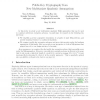EUROCRYPT
2012
Springer
12 years 9 months ago
2012
Springer
Abstract. Processing on encrypted data is a subject of rich investigation. Several new and exotic encryption schemes, supporting a diverse set of features, have been developed for ...
PKC
2012
Springer
12 years 9 months ago
2012
Springer
In this work, we study a new multivariate quadratic (MQ) assumption that can be used to construct public-key encryption schemes. In particular, we research in the following two di...
IACR
2011
13 years 6 months ago
2011
Abstract. The prospect of outsourcing an increasing amount of data storage and management to cloud services raises many new privacy concerns for individuals and businesses alike. T...
IACR
2011
13 years 6 months ago
2011
We give new methods for generating and using “strong trapdoors” in cryptographic lattices, which are simultaneously simple, efficient, easy to implement (even in parallel), a...
IACR
2011
13 years 6 months ago
2011
We propose a new homomorphic encryption scheme based on the hardness of decoding under independent random noise from certain affine families of codes. Unlike in previous latticeba...
CRYPTO
2011
Springer
13 years 6 months ago
2011
Springer
We present a somewhat homomorphic encryption scheme that is both very simple to describe and analyze, and whose security (quantumly) reduces to the worst-case hardness of problems ...
CRYPTO
2011
Springer
13 years 6 months ago
2011
Springer
Deterministic public-key encryption, introduced by Bellare, Boldyreva, and O’Neill (CRYPTO ’07), provides an alternative to randomized public-key encryption in various scenari...
141
click to vote
ACNS
2011
Springer
13 years 10 months ago
2011
Springer
It is a well known fact that encryption schemes cannot hide a plaintext length when it is unbounded. We thus admit that an approximation of it may leak and we focus on hiding its p...
ACNS
2009
Springer
14 years 4 months ago
2009
Springer
In this paper, we propose a notion of threshold tag-based encryption schemes that simplifies the notion of threshold identity-based encryption schemes, and we show a conversion fro...
SCN
2010
Springer
14 years 5 months ago
2010
Springer
Abstract. A hidden vector encryption scheme (HVE) is a derivation of identity-based encryption, where the public key is actually a vector over a certain alphabet. The decryption ke...




